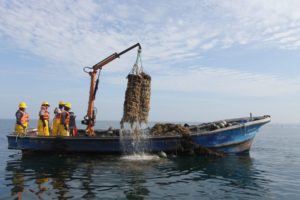The machas clams are also known in scientific terms as Mesodesma donacium. This is another bivalve mollusk that belongs to the Mesodesmatidae. The machas are native from South America, where they are very popular and consumed, especially in countries like Chile and Peru.
Table Of Content
Habitat Of The Machas Clams
These clams, as we have already mentioned, are native from South America. In a more specific way, it can be said that they are located between the waters that belong to the Sechura Bay; in the country of Peru, and the beaches of the Inío River in the  country of Chile.
country of Chile.
However, according to researches regarding the way of life of the machas clams; it is known that when they are in their natural habitat, these mollusks remain buried in the sand, especially in beaches where the waves are intense, and this is how they develop in all the stages of their life.
On the other hand, among other data in terms of distribution; it is usually easy to find macha clams; inhabiting the southern zone of the Isla Grande de Chiloé, in Chile. However, it is also known that the population of this species of mollusk has decreased in these areas. The capture in large quantities of the machas clams, as well as the pollution on the coasts and bays; are the main reasons that attempt against their integrity
Let´s learn more about how to caught these clams
Production and Trade of Machas Clams.
In terms of trade, since these clams are very popular in the Latin cuisine, the machas are caught in their natural habitats. This practice has been carried out for many years and is considered even ancient in South America.
In this way the capture of machas clams on the coasts, where they are found more easily; is something that has been carried out for thousands years, specifically on the coasts of Peru and Chile.
Now, according to the references; the number of captures of this animal for consumption is too high, since in 1997 only in the region of the South of Peru, 2800 tons of machas were fished. Due to these high statistics, the population of machas has lowered significantly through the years. However, several laws has been developed in order to regulate this activity.
Macha Clams in the Chilean Gastronomy
 Thanks to the delicious flavor provided by these clams, as well as their easy access especially in Chile and Peru; these mollusks are quite employed in the cuisines of their respective countries. The machas clams are very popular in Chilean dishes , as it is the case of the renowned dish “paila marina”, in several mollusk stews, and even in salads with fresh cheese and almonds.
Thanks to the delicious flavor provided by these clams, as well as their easy access especially in Chile and Peru; these mollusks are quite employed in the cuisines of their respective countries. The machas clams are very popular in Chilean dishes , as it is the case of the renowned dish “paila marina”, in several mollusk stews, and even in salads with fresh cheese and almonds.
They are usually found even packaged, since their distribution is also popular in an industrial way. For this reason it is very easy to make a homemade recipe with machas clams.
Threats Against Macha Clams
There is no doubt, that the high rates of capture that threaten its population; are the main threats against this species. However, the macha clams are also threatened by the pollution that occurs on the coasts where they usually live. This is to say, the main coasts and beaches of Chile and Peru. To understand these effects in the best way, we must point out that according to several researches on a more specific scale; there are references that on the beaches that make up the Maipo river, individuals of clams have been found contaminated with metals such as arsenic, lead and even mercury.
Now, if you take into account that these mollusks can present large quantities of the metals mentioned above, their contamination would be obvious, but if they are captured for human consumption the consequences could be even worse. Once the people consume these animals with high levels of contamination, would present significant health problems.
For example, in the case of mercury, if this metal is consumed in high quantities, short-term consequences can be observed, especially in the health of children and adolescents.
However, all the required measures have been taken, especially in legal terms, to improve this situation.

